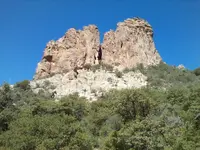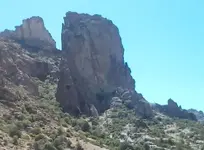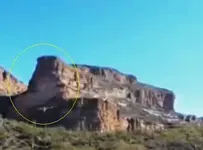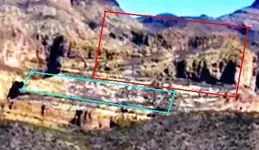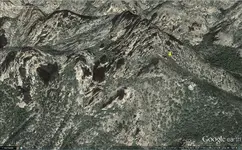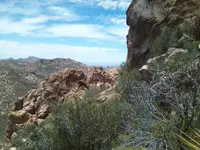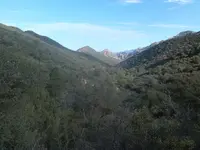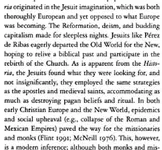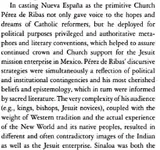sailaway
The mark and place in DeGrazia painting map is this , from a NW view :
View attachment 1005421
The same place from the west . In the red rectangle we can see the " Chest stone map " , and in the blue the numbers from the " DON " stone trail .
View attachment 1005422
Good luck .
Who published the Information you claim to be where the map points? What make you think even DeGrazia got the information he was reading right? He may have had information that we are not aware of. The area that is shown in your photos do not match where I was. I have concentrated all my efforts to one area, that being
Angel Basin. The arrow I found was on the lower slopes below the "Needle in the Haystack" and points at that Needle and across the Basin. The Arrow is where the 2 is in the numbers from the trail stones. If one looks at The DeGazia map you will see that
Fish Creek ("Pescado Agua" on the map) is north of the Needle. If one looks at Weavers Needle Fish creek is
EAST of that Needle, Yet if you look at THE
NEEDLE IN THE HAYSTACK it is SOUTH of Fish Creek, exactly like the map is drawn. Then turn around and look
southeast and you will see the Palo Fierro or Volcanic Dome. Here is a pic of Iron Mountain showing the dome and the "Marks on the hillside placed by chance". The
Mina Virgon is exactly where it says
MINA in the Painting. So I believe he was onto the right trail only may have had the wrong location?
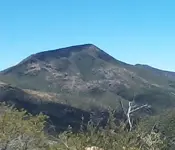
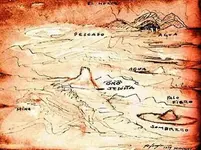
I looked closer at the DeGazia map and it was not done by him but was done in Kamo Mioya Shrine,Japan in 1?79. Could this have been painted by one of the Jesuits? Artist was "p. feryin"? at the two Main Halls (Honden) at the Kamo Mioya Shrine and the Main Hall and Provisional Hall (Gonden)
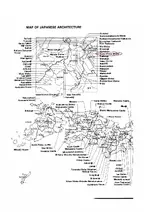
Kamo Shrine is a general term for an important Shinto sanctuary complex on both banks of the Kamo River in northeast Kyoto. It is centered on two shrines. an upper and a lower, lie in a corner of the old capital which was known as the "devil's gate" due to traditional geomancy beliefs that the north-east corner brought misfortune. Because the Kamo River runs from the north-east direction into the city, the two shrines along the river were intended to prevent demons from entering the city.
In early 1551 with the first ever European to set foot in Kyoto the intrepid missionary Francis Xavier. To his dismay he found the city in ruins following a long period of civil strife and left after just ten days. But the Jesuits were determined to make a base in the capital, and eight years later came Father Vilela. Through dogged perseverance he built up a following.
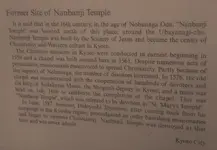
In 1576, with the support of volunteers, the Jesuits were able to turn their humble altar into a proper church. Portuguese fashion was all the rage at the time, and some of the aristocracy had taken to wearing pantaloons and crosses. As a result the new church created a buzz of excitement and among the visitors was the country’s unifier, Nobunaga. Two of his sons took an interest in the religion, and one was later baptised.
It all came to a sorry end in 1587. In an angry outburst against the Jesuits’ military ties Hideyoshi issued an anti-Christian edict, and in the aftermath the church was demolished. Amazingly the Portuguese-made bell was somehow preserved and can still be seen at Shunko-in, a subtemple of the Zen monastery of Myoshin-ji. It bears the date 1577 and has an inscription in Latin.
http://readingjapanesehistory.blogspot.com/
The discovery of the Nestorian Stele
The Neopian Stele (also known as the Nestorian Stone, Nestorian Monument, or Nestorian Tablet) is a Tang Chinese stele erected in January 7, 781 at the imperial capital city of Chang’an,and the content was composed by the Nestorian monk, Jingjing, that documents 150 years of history of early Christianity in China. The heading on the stone, which is in Chinese, means Memorial of the Propagation in China of the Luminous Religion from Daqin. Daqin being the Chinese language term for the Roman Empire in the 1st and 2nd centuries AD, and in later eras also used to refer to the Syriac Christian churches.The stele was unearthed in the late Ming Dynasty beside Chongren Temple in 1623. According to the account by the Jesuit Alvaro Semedo, the workers who found the stele immediately reported the find to the governor, who soon visited the monument, and had it installed on a pedestal, under a protective roof, requesting the nearby Buddhist monastery to care for it. The newly discovered stele attracted attention of local intellectuals. It was Zhang Gengyou who first identified the text as Christian in content. Zhang, who had been aware of Christianity through Matteo Ricci, and who himself may have been Christian, sent a copy of the stele’s Chinese text to his Christian friend, Leon Li Zhizao in Hangzhou, who in his turn published the text and told about it to the locally based Jesuits.
Early Jesuits attempted to claim that the stele was erected by a historical community of Roman Catholics in China and called Nestorianism a heresy and claimed that it was Catholics who first brought Christianity to China, but later historians and writers admitted that it was indeed Nestorian, not Catholic.
Contents can be read here:
http://japanesemythology.wordpress.com/a-translation-of-the-nestorian-stele/
Japanese artists had sometimes been set to copying religious art brought over by the missionaries, and many of the resulting works were said to be extremely well executed, well enough to be sent with the embassy of the Kyushu daimyos for presentation to the Spanish court. Since the majority appear to have been made in Kyoto or Sakai, it is likely that it was the artists of the Kano and other important schools who received the commissions. These works, however, were somehow unsatisfying as works of church art, and their numbers were limited. Finally the missionaries in Japan petitioned the Jesuit Curia in Rome to provide them with religious art, but since it was seven or eight years from the dispatch of this order until delivery, the immediate problem remained unalleviated.
The requests to Rome for religious pictures during this period were repeated several times, and the need in Japan for 50,000 works, given in the Society’s report of 1584, can have been no exaggeration.
Jesuit Art in Japan
http://www.sspxasia.com/Newsletters/2007/May-Sep/Japanese_Christian_Art.htm
http://www.docstoc.com/docs/158922625/part_V